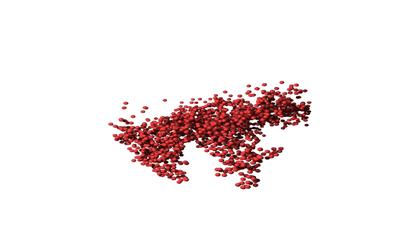
IMAGE: Lehigh University researchers saw a “tempest in a teapot ” as they observed the microstructure evolution of colloid-polymer film during the drying process.
view more
Credit: Kaewpetch, T., Gilchrist, J.F./Lehigh University
Dull. Slow. Unchanging. Like watching paint dry.
But take a closer look at that paint–all the way down to the nanoscale–and there’s a lot more going on than you might think.
Researchers in the Gilchrist Laboratory in Lehigh University’s P.C. Rossin College of Engineering and Applied Science are observing the evolution of coatings as they dry with groundbreaking microscale precision. Their results were recently published in Scientific Reports.
Thin film coatings do much more than spruce up walls. For example, they can be used as pharmaceutical devices in edible films, similar to those to deliver drugs used to fight the opioid epidemic. How these coatings dry can change their properties, which is especially important for films used in drug delivery.
In their paper, “Chemical vs. mechanical microstructure evolution in drying colloid and polymer coatings,” the Lehigh researchers looked at how particles rearrange themselves during drying when their interactions are tuned. These particles behaved as a surrogate for the active pharmaceutical ingredient in a drug delivery film.
Graduate student Titiporn Kaewpetch looks directly inside these films using high speed confocal laser scanning microscopy to take thousands of images that give nanoscale details of how particles flow and assemble during drying. Gigabytes of data for each film are rendered to reveal their 3-D structure, giving simulation-like detail on the otherwise hidden internal processes that happen.
The researchers found that when particles attract each other, they form a scaffold that buckles and breaks during drying due to the motion of the top interface. “The microstructure for attractive particles at each point during drying is related to the history of the film evolution,” says James Gilchrist, a professor in the Department of Chemical and Biomolecular Engineering. Their 3-D analysis of the microstructure evolution reveals clear signatures of this process throughout drying as compared with those where particles are repulsive.
“In real drug delivery systems, there are many ingredients interacting with each other, always changing concentration and their interactions throughout drying,” says Gilchrist. “By reducing this process to the essential ingredients, we can see these interactions as they happen. This may allow new insights into manufacturing of these films.”
This paper is based upon work supported by the National Science Foundation (grant No. 1936541). Kaewpetch is supported by the Royal Thai Scholars program.
Related Links:
###
TDnews














